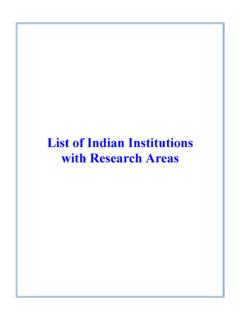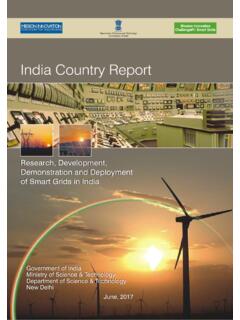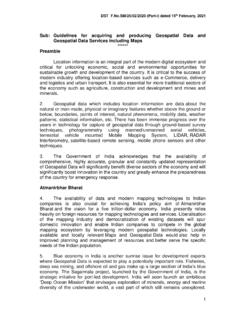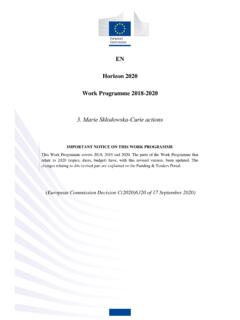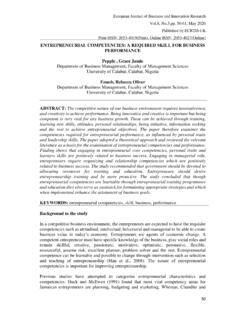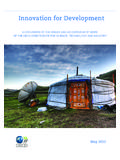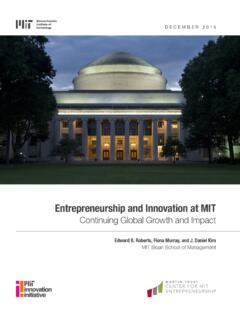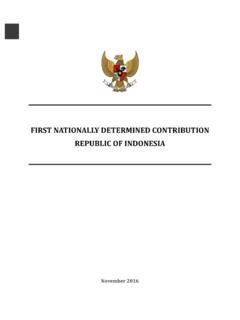Transcription of Science, Technology, and Innovation Policy
1 Draft STIP Doc Science, technology , and Innovation Policy Government of India Ministry of Science & technology Department of Science & technology December, 2020 Draft STIP Doc Dec 2020 1 Science, technology , and Innovation Policy (STIP) Table of Contents EXECUTIVE SUMMARY 2 I. Building a robust Science, technology and Innovation Ecosystem for an Atmanirbhar Bharat 7 II. Evolution of STI Policies in India 9 III. Chapters 11 Chapter 1: Open Science 11 Chapter 2: Capacity Development 14 Chapter 3: Financing STI 19 Chapter 4: research 24 Chapter 5: Innovation and Entrepreneurship 27 Chapter 6: technology Development and Indigenisation 33 Chapter 7: Equity and Inclusion 39 Chapter 8: Science Communication and Public Engagement 43 Chapter 9: International STI Engagement 47 Chapter 10: STI Governance 52 Chapter 11: STI Policy Governance 57 IV.
2 Implementation Framework 61 V. Monitoring, Evaluation and Feedback Framework 61 VI. Vision 61 Draft STIP Doc Dec 2020 2 Science, technology , Innovation Policy (STIP) Executive Summary Science, technology and Innovation (STI) are the key drivers for economic growth and human development. For India to march ahead on a sustainable development pathway to include economic development, social inclusion and environmental sustainability for achieving an Atmanirbhar Bharat'', a greater emphasis will be given on promoting traditional knowledge system, developing indigenous technologies and encouraging grass root The emergence of disruptive and impactful technologies poses new challenges and simultaneously greater opportunities.
3 The COVID-19 pandemic provided a compelling opportunity for research and Development (R&D) institutions, academia and industry to work in unison for sharing of purpose, synergy, collaboration and cooperation. The new Science, technology , Innovation Policy aims to bring about profound changes through short-term, medium-term, and long-term mission mode projects by building a nurtured ecosystem that promotes research and Innovation on the part of both individuals and organizations. It aims to foster, develop, and nurture a robust system for evidence and stakeholder-driven STI planning, information, evaluation, and Policy research in India. The Policy will identify and address strengths and weaknesses of the Indian STI ecosystem to catalyse socio-economic development of the country and also make the Indian STI ecosystem globally competitive.
4 A broad summary of Science, technology and Innovation Policy (STIP) is given as under- 1. STIP will lead to the establishment of a National STI Observatory that will act as a central repository for all kinds of data related to and generated from the STI ecosystem. It will encompass an open centralised database platform for all financial schemes, programmes, grants and incentives existing in the ecosystem. The Observatory will be centrally coordinated and organized in distributed, networked and interoperable manner among relevant stakeholders. 2. A future-looking, all-encompassing Open Science Framework will be built to provide access to scientific data, information, knowledge, and resources to everyone in the country and all who are engaging with the Indian STI ecosystem on an equal partnership basis.
5 All data used in and generated from publicly-funded research will be available to everyone under FAIR (findable, accessible, interoperable and reusable) terms. A dedicated portal to provide access to the outputs of such publicly-funded research will be created through Indian Science and technology Archive of research (INDSTA). Additionally, full text of final accepted author versions of manuscripts (postprints and optionally preprints) supported through public funding will be deposited to an institutional or central repository. The Policy will create pathways for Draft STIP Doc Dec 2020 3 the Government to negotiate with journal publishers for a one nation, one subscription Policy whereby, in return for one centrally-negotiated payment, all individuals in India will have access to journal articles.
6 3. Strategies to improve STI education making it inclusive at all levels and more connected with the economy and society will be developed through processes of skill building, training and infrastructure development. Engaged Universities will be created to promote interdisciplinary research to address community needs. Higher Education research Centres (HERC) and Collaborative research Centres (CRC) will be established to provide research inputs to policymakers and bring together stakeholders. Online learning platforms will be developed using Information and Communication technology (ICT) to address the issue of accessibility and to promote research and Innovation at all levels.
7 Teaching-learning centres (TLCs) will be established to upskill faculty members which in turn will improve the quality of education. 4. With an aim to expand the financial landscape of the STI ecosystem, each department/ ministry in the central, the state and the local governments, public sector enterprises, private sector companies and startups will set up an STI unit with a minimum earmarked budget to pursue STI activities. Extramural funding will be diversified and enhanced to double the share of extramural R&D support of the Central government agencies in the Gross Domestic Expenditure on R&D (GERD) in the next five years. Each State will earmark a percentage of the state allocation for STI-related activities under a separate budget head.
8 Foreign Multi National Companies (MNCs) will collaborate with domestic private and public sector entities on projects aligned to national needs and priorities. STI investments will be increased through boosting fiscal incentives, enhancing support to industry, especially Medium Small Micro Enterprises (MSMEs), for pursuing research through Innovation support schemes and other relevant means on a need basis. Hybrid funding models with enhanced participation from public and private sectors will be created through the Advanced Missions in Innovative research Ecosystem (ADMIRE) initiative. To ensure systematic governance of the expanded STI financing landscape, an STI Development Bank will be set up to facilitate a corpus fund for investing in direct long term investments in select strategic areas on various long and medium-term projects, commercial ventures, start-ups, technology diffusion and licensing etc.
9 General Financial Rules (GFR) will be suitably amended for large scale mission mode programmes and projects of national importance and to facilitate ease of doing research . Efficient disbursement, communication, monitoring and evaluation mechanisms (time-bound peer reviews along with technical and transactional audits) will be set up to support conducive investment. 5. The Policy aims to create a fit for purpose, accountable research ecosystem promoting translational as well as foundational research in India in alignment with global standards. research and Innovation Excellence Frameworks (RIEF) will be developed Draft STIP Doc Dec 2020 4 to enhance the quality of research along with promotion of engagements with relevant stakeholders.
10 Proper guidelines will be formulated to enhance the operating and safety protocols related to R&D. research culture will be reoriented to recognize social impacts along with academic achievements. 6. The Policy envisions strengthening of the overall innovative ecosystem, fostering Science & technology (S&T)- enabled entrepreneurship, and improving participation of the grassroots levels in the research and Innovation ecosystem. An institutional architecture to integrate Traditional Knowledge Systems (TKS) and grassroots Innovation into the overall education, research and Innovation system will be established. Collaborations between grassroots innovators and scientists will be facilitated through joint research projects, fellowships and scholarships.

